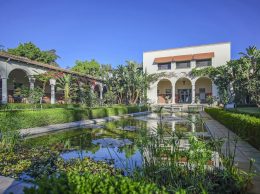UCSB named West Coast hub for Photonics Institute
IN THIS ARTICLE
- Latest news Topic
- Staff Report Author
By Staff Report Monday, July 27th, 2015
UC Santa Barbara’s Institute for Energy Efficiency will play a lead role in a $110 million federal program to develop new electronic products using the next generation of chip technology.
UCSB will become the west coast hub for the newly formed American Institute for Manufacturing of Photonics (AIM), teaming with lead institution State University of New York Poly. The UCSB team will be led by IEE director John Bowers, a pioneer in the field of photonics or the use of light to transmit vast quantities of data at once-unheard-of speeds.
“AIM and UC Santa Barbara are leading a revolution,” said Bowers in a statement provided to the Business Times. UCSB Chancellor Henry Yang cited 30 years of leadership in the field of photonics at the campus, including three of UCSB’s Nobel prizes.
The institute was formally announced July 27 and it is the sixth public-private partnership launched under the Obama Administration’s National Network for Manufacturing Innovation program.
The home base for the new center will be in Rochester, N.Y., where Vice President Joe Biden was on hand for the official kick off. The institute will “”secure U.S. leadership in the manufacture of next-generation Internet, health care and defense capabilities,” according to excerpts of his speech released in advance.
The Defense Department will contribute $110 million to a fund that is expected to exceed $600 million when private and state commitments are added up.
New York pledged $250 million to support the effort, according to reporting by the Rochester Democrat and Chronicle. Massachusetts and California also pledged state funds, the report said.
The Defense Department has long been a supporter of efforts in advanced photonics and imaging in areas such as radar and electronic warfare.
The grant is a shot in the arm for upstate New York, which has lost manufacturing jobs to Asia, Mexico and the southwestern U.S.
Corporate partners in developing manufacturing programs will include Intel, Hewlett Packard, Agilent, Lockheed and Raytheon, a major employer in Santa Barbara County.
Photonics has been a rich source of startups for the tri-county region, with companies such as Aurrion, Agility, Calient Networks, Soraa and others being spun out of research conducted by Bowers and others.
Getting the next generation of computer chips is important because photonic integrated circuits hold out the promise of using less energy than the current generation of switching devices.
Creating the new technology involves combining lasers with integrated circuits to improve speed and capacity. “UCSB is a worldwide leader in integrating lasers into silicon,” said UCSB College of Engineering Dean Rod Alferness in a statement.
Other participating universities include MIT, Stanford, University of Arizona, Cal Tech, Columbia University, the University of Virginia and UC Davis, UC Berkeley and UC San Diego.











